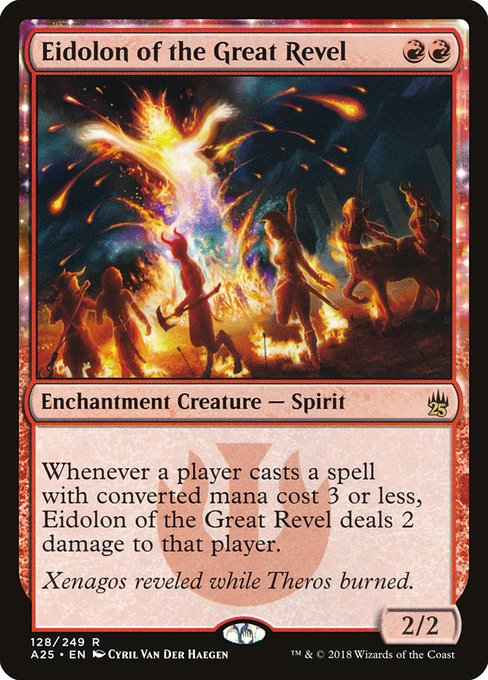
Image courtesy of Scryfall.com
Using Eidolon of the Great Revel to model red deck outcomes
In the colorful chaos of red spells, Eidolon of the Great Revel stands as a badge of tempo and tension 🧙♂️🔥. This Masters 25 reprint is a rare enchantment creature with a lean body and a big punch: mana cost {R}{R}, a crisp 2/2, and a trigger that shreds the math of any opponent casting low-cost spells. Whenever a player casts a spell with mana value 3 or less, Eidolon deals 2 damage to that player. It’s the sort of card that makes you re-check your curve, count your cards, and maybe second-guess that Lightning Bolt you drew on the draw step ⚔️. The flavor text—“Xenagos reveled while Theros burned.”—tells you this is a card built for risk, speed, and the occasional reckless victory lap.
From a design and deck-building perspective, Eidolon changes how you model outcomes in aggressive red shells. The card’s trigger is not merely a doorway to direct damage; it’s a deterministic pressure valve that reshapes the expected damage curve of your opponent’s plan. In other words, Eidolon doesn’t just burn the opponent; it turns their cheap spells into predictable, fatigue-inducing events. For players who love to quantify every turn, Eidolon becomes a lens for studying how quickly a game can tilt when early could-be-splashy plays become reliable pain points 🔥💎.
Quantifying the effect: a practical modeling approach
To model deck outcomes with Eidolon, think in terms of probability distributions over spell casts. A red deck often runs a large portion of cheap spells—1- to 3-mana threats and cantrips. Eidolon’s trigger scales with the rate of those spells, so a simple starting model looks like this:
- Define the deck’s spell distribution by mana value (MV). For a typical red tempo shell, MV1 spells (Lightning Bolt, Shock, some one-mana; MV2 spells like Torbran or similar) form the core, with MV3 spells serving as stabilizers or finishers.
- Estimate the chance your opponent casts an MV ≤ 3 spell each turn, conditioned on their available mana and game state. This yields an expected number of triggers per turn.
- Translate each trigger into 2 damage to the caster. In a head-to-head match, that’s a measurable portion of the life total across the early turns, which interacts with burn spells you cast to finish the game.
- Factor in the odds of Eidolon occupying a land slot or being removed, since availability of the card in play changes the expected value significantly. This is where Monte Carlo-style simulations shine, running hundreds or thousands of game sketches to reveal average outcomes and variance.
In practice, you’ll see several salient effects. First, the card accelerates the time-to-tap for the opponent’s early plays. If the opponent relies on a fast curve of MV1 and MV2 spells, Eidolon’s presence compresses the path to lethal damage, effectively raising the win probability of your aggressive plan on turns 3–5 🔥. Second, the variance of outcomes grows in unusual ways: a blue decks’ cantrips or a miracle draw from your opponent can swing the battlefield dramatically, but Eidolon keeps the pressure steady by delivering a steady stream of pain whenever cheap spells are cast 🎯.
“Eidolon rewards aggressive pacing, but it punishes slow, expensive lines of play with a direct, almost surgical, dose of pain.”
From a pricing and collection angle, Masters 25’s Eidolon offers a rare-lean price point for a double-red cornerstone that can slot into modern or legacy red shells, depending on the metagame. The card’s rarity, alongside its foil and nonfoil finishes, makes it an appealing target for players who love deck-building experiments as much as they love fast wins. Expect the card to sit in the $1–$2 range in many formats today, with foil nudges that push toward the $3 mark for collectors and enthusiasts 📈.
Design, play, and the art of measurement
Statically, Eidolon’s effect is simple, but its impact scales with your deck’s design. If you’re leaning into a pure burn strategy, Eidolon is a reminder that your own cheap spells may become “self-checkouts” for your opponent’s life total—because the trigger targets the caster, not the creature’s controller. If you blend reach with tempo, the card’s damage becomes a reliable clock you can read in the late game, helping you decide when to push for early aggression or rotate into finishers. The art and flavor weave into this narrative; a 2/2 spirit with a penchant for red heat aligns with Xenagos’ mythic menace—an effect that’s as much about pressure as it is about raw damage 🧙♂️.
When designing a deck around Eidolon, you’ll want to consider several practical constraints. First, ensure you have enough cheap win conditions to benefit from the consistent pressure without stalling out. Second, safeguard Eidolon against removal or returning to your hand—without him, the damage pipeline slows to a trickle. Finally, remember that the card is legal in formats like Modern, Legacy, Commander, and many other non-Standard arenas, making it a flexible piece for a broad audience of red fans who crave both math and mayhem 🎲.
And if you’re in the market for a little real-world gear to complement your MTG focus, this Non-slip Gaming Mouse Pad Neon Vibrant Polyester Surface is a neat nod to the tactile joy of table-top strategy. It’s the kind of accessory that keeps your desk as sharp as your plays, with a bright design that won’t slip under pressure.
Non-slip Gaming Mouse Pad Neon Vibrant Polyester SurfaceMore from our network
- https://crypto-acolytes.xyz/blog/post/designing-fair-currencies-a-developers-guide-to-transparent-economies/
- https://blog.digital-vault.xyz/blog/post/mastering-cross-functional-collaboration-practical-management-tips/
- https://blog.rusty-articles.xyz/blog/post/dr3-bright-star-handling-revealed-by-a-far-blue-giant/
- https://blog.digital-vault.xyz/blog/post/infernal-phantom-lore-echoes-real-world-legends-in-mtg/
- https://crypto-acolytes.xyz/blog/post/secret-solana-tools-every-meme-coin-gamer-should-try/